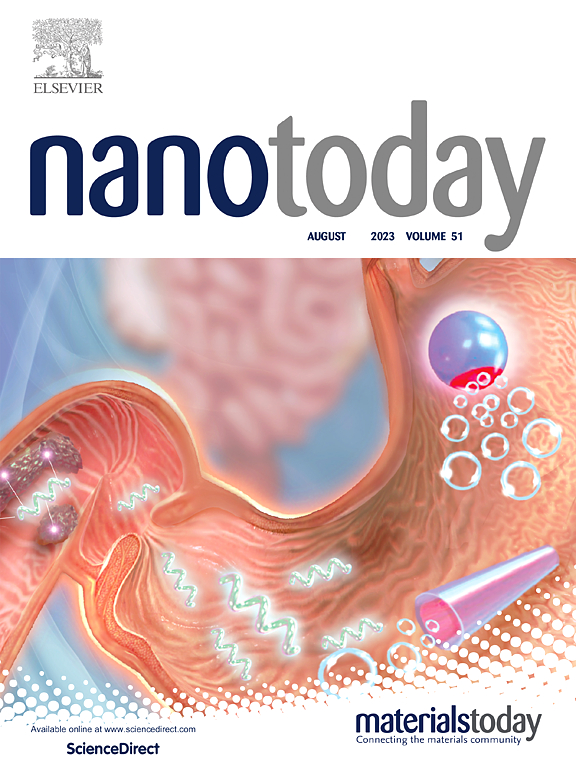级联反应纳米protacs用于肿瘤特异性ALK蛋白降解和增强癌症治疗
IF 13.2
1区 材料科学
Q1 CHEMISTRY, MULTIDISCIPLINARY
引用次数: 0
摘要
靶向嵌合体蛋白水解(PROteolysis TArgeting Chimeras, PROTACs)作为一种很有前景的治疗方式,已被用于降解特定的致病蛋白。然而,PROTACs的体内抗肿瘤效果因其药代动力学差和肿瘤分布不充分而严重受损,限制了其临床应用。在此,我们报道了一种pH/酶级联反应的纳米protacs (CRNPs),通过将组织蛋白酶b可切割的Gly-Phe-Leu-Gly (GFLG)连接到超pH敏感(UPS)纳米平台上,以增强肿瘤特异性ALK降解和精确的癌症治疗。在生理条件下,crnp具有稳定的纳米结构,直径为33 nm,在pH 6.0时快速解离,随后被组织蛋白酶B裂解,有效释放PROTAC有效载荷。这进一步导致有效的ALK降解,p-ALK降低,G0/G1期细胞周期阻滞和抑制肿瘤细胞增殖。此外,级联反应设计通过延长循环寿命以及增强PROTAC的肿瘤特异性积累和释放显着改善了体内药代动力学。因此,CRNPs显著增强了抗肿瘤功效,在Karpas299肿瘤模型中实现了超过94% %的抑制,同时在体内表现出良好的生物相容性。这些发现突出了级联反应纳米载体通过攻击致病性蛋白来递送PROTACs以对抗多种癌症的潜力。本文章由计算机程序翻译,如有差异,请以英文原文为准。
Cascade-responsive nano-PROTACs for tumor-specific ALK protein degradation and enhanced cancer therapy
PROteolysis TArgeting Chimeras (PROTACs), as a promising therapeutic modality, have been exploited to degrade specific pathogenic proteins. However, the in vivo antitumor efficacy of PROTACs is seriously impaired by its poor pharmacokinetics and insufficient tumor distribution, consequently restricting their clinical applications. Herein, we report a pH/enzyme cascade-responsive nano-PROTACs (CRNPs) by integrating the cathepsin B-cleavable Gly-Phe-Leu-Gly (GFLG) linked PROTAC onto ultra-pH-sensitive (UPS) nanoplatform for enhanced tumor-specific ALK degradation and precise cancer therapy. The CRNPs exhibit a stable nanostructure with a diameter of 33 nm under physiological conditions, while rapidly dissociate at pH 6.0 and are subsequently cleaved by cathepsins B to effectively release the PROTAC payload. This further results in efficient ALK degradation, p-ALK reduction, G0/G1 phase cell cycle arrest, and suppression of tumor cells proliferation. Moreover, the cascade-responsive design dramatically improves the in vivo pharmacokinetics via prolonged circulation lifetime as well as enhanced tumor specific accumulation and release of PROTAC. Consequently, CRNPs significantly augment the antitumor efficacy, achieving with over 94 % suppression in Karpas299 tumor models, while demonstrating good biocompatibility in vivo. These findings highlight the potential of cascade-responsive nanocarriers for delivering PROTACs to combat a wide range of cancers by attacking their pathogenic proteins.
求助全文
通过发布文献求助,成功后即可免费获取论文全文。
去求助
来源期刊

Nano Today
工程技术-材料科学:综合
CiteScore
21.50
自引率
3.40%
发文量
305
审稿时长
40 days
期刊介绍:
Nano Today is a journal dedicated to publishing influential and innovative work in the field of nanoscience and technology. It covers a wide range of subject areas including biomaterials, materials chemistry, materials science, chemistry, bioengineering, biochemistry, genetics and molecular biology, engineering, and nanotechnology. The journal considers articles that inform readers about the latest research, breakthroughs, and topical issues in these fields. It provides comprehensive coverage through a mixture of peer-reviewed articles, research news, and information on key developments. Nano Today is abstracted and indexed in Science Citation Index, Ei Compendex, Embase, Scopus, and INSPEC.
 求助内容:
求助内容: 应助结果提醒方式:
应助结果提醒方式:


